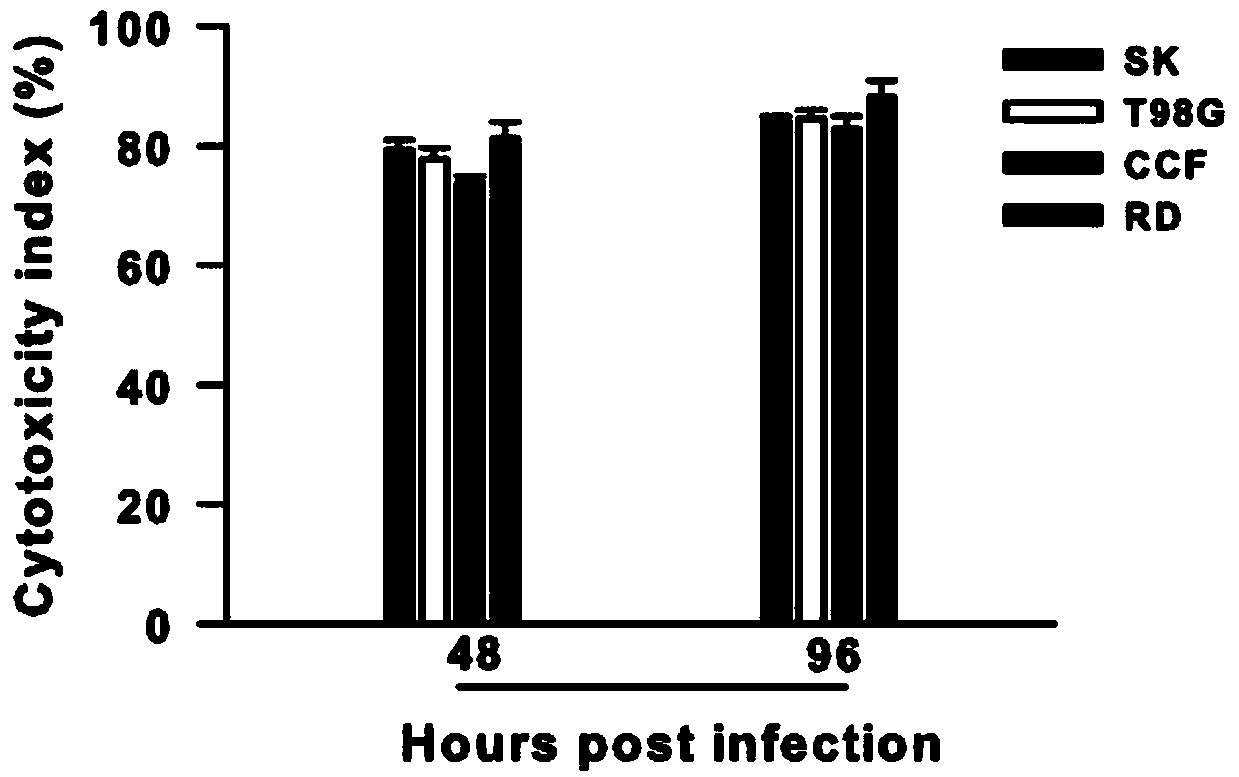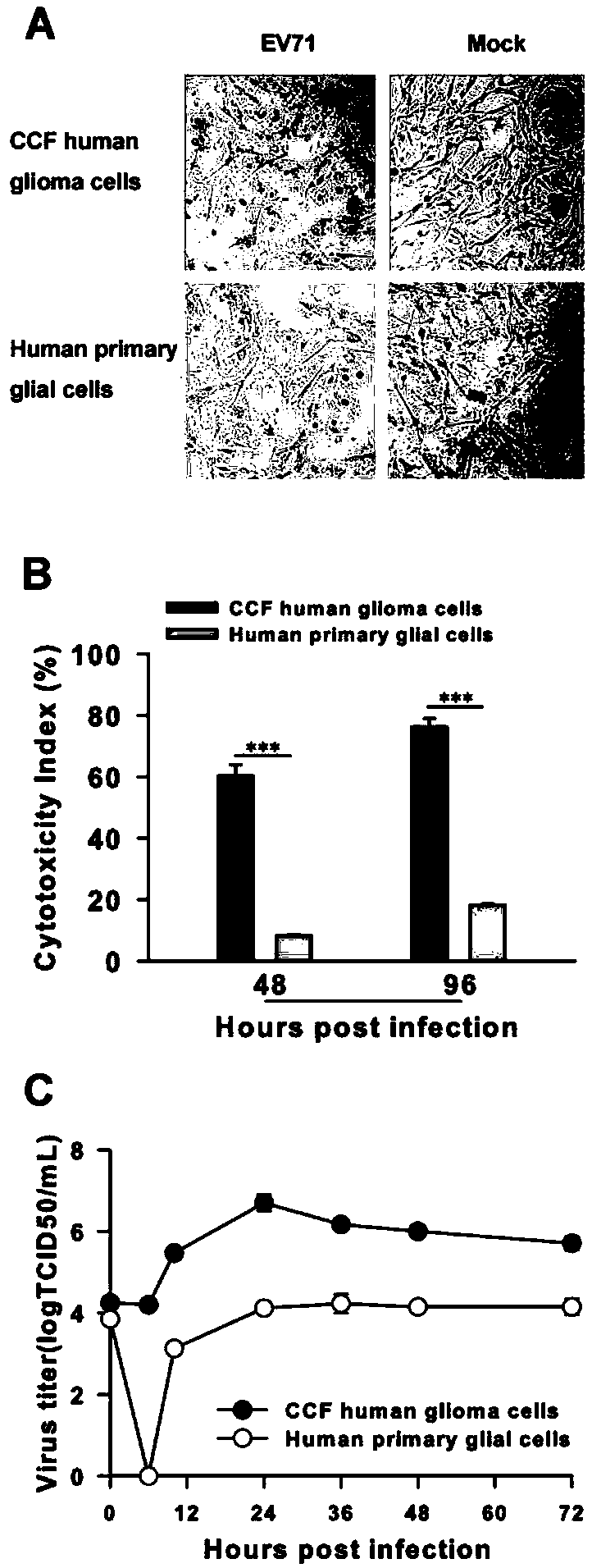Application of enterovirus type-71 in preparing oncolytic medicine
A technology of enteroviruses and drugs, applied in the field of oncology and virology, to achieve the effects of tumor growth inhibition, volume reduction, and survival rate improvement
- Summary
- Abstract
- Description
- Claims
- Application Information
AI Technical Summary
Problems solved by technology
Method used
Image
Examples
Embodiment 1
[0033] Oncolytic effect of enterovirus 71 on different monolayers of tumor cells:
[0034] Enterovirus 71 BrCr infection (MOI=20) monolayer human neuroblastoma cell line SK-N-SH (SK), microglioma cell line T98G, glioma cell line CCF-STTG1 (CCF ) and the rhabdomyosarcoma cell line RD, by lactate dehydrogenase (LDH) cytotoxicity assay to evaluate the cell lysis response caused by viral oncolysis. Viral oncolysis causes tumor cell apoptosis or necrosis, resulting in damage to the cell membrane structure, resulting in the release of LDH in the cytoplasm into the culture medium. Quantitative analysis of tumor cell lysis responses can be achieved by detecting the activity of LDH released from cells with ruptured plasma membranes into the culture medium. The calculation method is as follows: tumor cytotoxicity index (%)=(absorbance of virus-treated sample-absorbance of control well) / (absorbance of maximum cell enzyme activity-absorbance of control well)×100. We respectively detecte...
Embodiment 2
[0037] Oncolytic effects of different genotypes of enterovirus 71 on monolayer glioma cells:
[0038] 1) EV71 has the targeting ability to kill tumor cells
[0039] Enterovirus type 71 BrCr strain infected (MOI=1) human glioma cell line CCF-STTG1 and normal glial cells (cells without any treatment as control, Mock group), and the cytopathic changes were observed through an inverted microscope , LDH assay to detect cell lysis reaction, one-step growth curve to detect virus amplification.
[0040] The result is as figure 2 As shown in middle A, EV71 infection of glioma cells can cause significant cytopathic reactions. In contrast, EV71 infection of normal glial cells only causes local cell rounding and shrinkage. Such as figure 2 As shown in middle B, after 48 hours of EV71 infection, the cytotoxicity indexes of glioma cells and normal glial cells were 60.2% and 8.2%, respectively, and the difference was extremely significant (P﹤0.001); after 96 hours of EV71 infection, the...
Embodiment 3
[0049] Oncolytic effect of enterovirus 71 in three-dimensional glioma cell spheres:
[0050] Add 200 microliters of tumor cell suspension (0.5×10 4 cells / ml), 37°C and 5% CO 2 After culturing for 4 days under certain conditions, tumor cell pellets with a diameter of about 500 microns were obtained. Enterovirus 71 infects tumor cell pellets, observes morphological changes with an inverted microscope, and detects cell viability with CCK-8 assay. The calculation method of cell viability is as follows: relative cell viability of tumor cell spheroids (%)=(absorbance of virus-treated tumor cell spheroid samples-absorbance of control wells) / (absorbance of untreated tumor cell spheroid samples-absorbance of control wells)×100. We detected the relative cell viability of the tumor cell spheroids after 4d and 7d of virus infection respectively.
[0051] Such as Figure 4 As shown in middle A, after EV71 infection, the integrity of the tumor cell spheres can be destroyed, making the e...
PUM
| Property | Measurement | Unit |
|---|---|---|
| Diameter | aaaaa | aaaaa |
| Volume | aaaaa | aaaaa |
| Titer | aaaaa | aaaaa |
Abstract
Description
Claims
Application Information
 Login to View More
Login to View More - R&D
- Intellectual Property
- Life Sciences
- Materials
- Tech Scout
- Unparalleled Data Quality
- Higher Quality Content
- 60% Fewer Hallucinations
Browse by: Latest US Patents, China's latest patents, Technical Efficacy Thesaurus, Application Domain, Technology Topic, Popular Technical Reports.
© 2025 PatSnap. All rights reserved.Legal|Privacy policy|Modern Slavery Act Transparency Statement|Sitemap|About US| Contact US: help@patsnap.com



